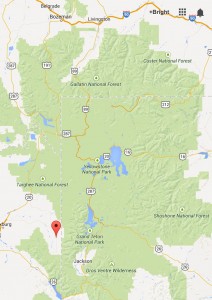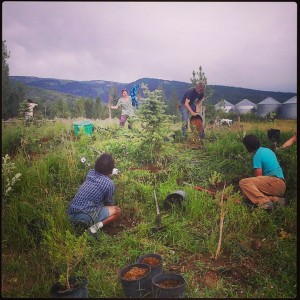Holistic Context
The project 8 geographical & metaphysical coordinates were set for Driggs, ID. It is in the volcanic region of Yellowstone, a place known for its active hydro-geothermal activity and constant, though incredibly minor, earthquakes. It’s surrounded by many national forests and wilderness, including Grand Tetons National Park, donated by the Rockefellers in 1943. Jackson Hole, the largest town across the pass, is an increasingly popular ski town, and its residents & tourists also enjoy the climbing, hiking, biking, and wildlife in summer.
Taiga and her husband Christian are building a home and educational center in the Teton Valley. Gaining insight from their time with the +Panya Project in Thailand and inspiration from the +Possibility Alliance in MO, they are becoming a hub in the Teton region. Through permaculture design, the personal connections, and their commitment to uplifted living, several experiments took place this summer. Awareness was focused largely in the following three areas.
Earthship
The first was the building of an earthship home.
This is the main focus and motivator for the context of the summer, namely, getting a house built to the point where they could stay in it during the winter. This included carpenter friends, early-arrival interns, and other volunteers. Even though there were lists of activities to get through, the importance of order of process in building a house is specific, and about 50% unknown until faced with the next step.
The house is actually an “earthship-inspired” building as a few points from the original +Biotecture classics; as an example, they put their front door through their back tire berm, and included a double door system to balance the thermal stock from the surrounding tires. Driggs is about the same altitude as the New Mexican desert where this style was pioneered – in the 6000s. The sun angle and seasons are relatively similar.
Another point of interest is a strict and focused adherence to county code. At certain stages in the building, there was coordination with officials to inspect electrical (for example, they came to make sure there was an outlet every 6 feet in every habited room), plumbing, and wood work, all according to an engineer-approved plan that was approved for certain earthquake measures. This was what set most of the work tasks. One of our most productive streaks with the interns was laying several layers of leveled gravel, plastic, insulation, PEX pipe, and grating in preparation for a concrete crew to come pour the floor (which actually ended up being delayed by wet conditions).
In the end, the build was a playground of creative problem-solving, in wood and earth and metal. A problem, and a solution. We managed with the interns to build a living roof, start the in-fill for the inside tire wall, level & prepare the floor, and insulate the roof. The roof was built, tar papered, and crimped, and the concrete was poured and stained. Most of the south wall is enclosed by windows.
Gift Economy Education
The second was an educational model of a gift economy internship.
Permaculture is a 72 hour educational model that equips you with the basic patterns needed to sustain a garden (water, soil, seeds), and the most basic patterns of +green-meme ethics (earth care, people care, fair share), as well as providing the starting points to skill paths such as building, herbalism, primitive skills, consulting, and all manner of regenerative offerings & service.
One of the major conversations within the teaching movement is the ability to make this type of education, which many working within believe is one of the most efficient ways to rebalance human systems at many scales, as accessible as possible.
In the effort of offering this experience at a live build, set to the background of regenerative soil, plant, and people systems, they offered three meals a day & a spot to camp, access to composting toilets and occassionally hot showers, a fully equipped kitchen with a full spread garden, community gathering space, and even cubbies for each guest.
Lessons were integrated after a full work-day, often out on the work site.
We had three facilitators. Christian, also acting as the project manager at the work site, had the most teaching experience. Geoffery had been teaching with Christian among the past 5 years. Bright Sky took the PDC certification with both of them in February 2012. We met before the course to set a daily schedule, weekly schedule, expected responsibilities, and intentions for the 6 weeks.
The final difference between cash invested into the course (CI) minus cash received in kind (CK) = ~$2500.
In total I facilitated approximately 4.5 hours of classroom time, and supported approximately 10 hours of others facilitating classroom time. The rest of the time was spent on the site, processing food, garden tending, and designing systems and to-do lists.
+See Journal Exerpts
The lesson I designed specifically for the course detailed many of the course expenses, the expected wage of a permaculture livelihood, and questions about different forms of capital, as well as a pop quiz on systems, inspired by the +EcoRise EcoSystem.
Traditional Business
The third is a traditional business model – selling a product for money. We sold a 10″ pizza for $11-15.
This was the most fun mode. My job was a cashier at the farmer’s market. Three of us ran the stand – Taiga topping pizzas, Becky running the oven & fire, and myself as Bright Sky taking orders and money. Most times after the market I would feel lighter and ready for more social interaction – it was a very pleasant experience to provide people with nutritious food. And nutritious interaction! During the clown camp we brought a whole comedic performance to the market.
Each ingredient was sourced from either a local, organic, or biodynamic source. There are at least three biodynamic farms in Teton Valley, one of which has a stand across from ours at the market (handy when we start to run low on certain ingredients). This means they use certain biological/geological additives, awareness of astrological positioning, mostly the moon, and encourage the most internal biomass recycling possible. Ingredients that are difficult to find well-produced in the bioregion, such as wheat flour and salt for the dough, were sourced from organic producers in other parts of the country.
Each step of the process, from the dough mixing, to the sauce prep, to frying sausage, was intentionally fresh and delicious, done in small batches each week.
Each pizza is made to order on a hearth fired with lodge pole pine.
Needless to say, it’s pretty damn good pizza.
Conclusion
To set yourself up for success, surround yourself with good people, do your best to eat food that will nourish you, and pay attention to your inputs and outputs. Honesty is not always the easiest thing. Is it true? Is it necessary? Is it kind?
Many pictures in this report are borrowed from the +Higher Elevation Permaculture Instagram for educational purposes.





